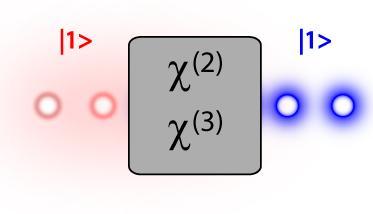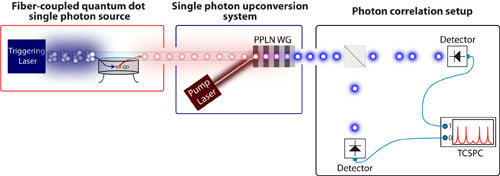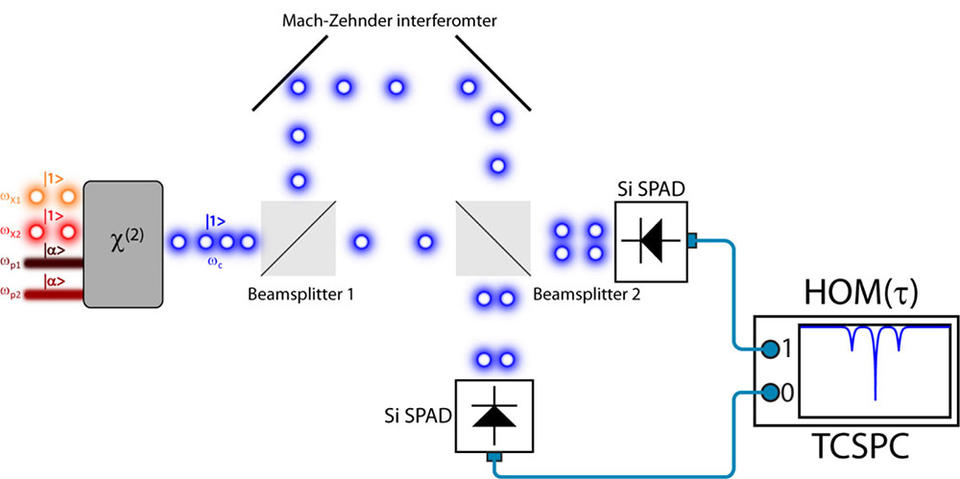Summary
Optical frequency conversion, in which the color of light is changed, is a process that has numerous applications in physics and technology. For example, green laser pointers typically involve second harmonic generation, where a strong beam produced by a laser at 1064 nm is frequency doubled in a nonlinear crystal to produce a visible beam at 532 nm. From the perspective of quantum and classical information processing, the ability to manipulate the color of light, and in particular, quantum states of light, can be an extremely important resource. First, it can be used to connect quantum systems operating in different frequency regions. For example, high performance quantum memories often accept photons in the visible spectrum. However, stable single photon generation in the telecommunications band, which is in the near-infrared, might be preferable because low-loss, long-distance transmission of light through optical fibers is possible at those wavelengths. Frequency conversion, if accomplished in a manner that preserves all other quantum properties of light, can enable interfacing between these different components of future quantum information processing systems. Such quantum frequency conversion may also be particularly relevant for solid-state quantum optical systems, such as those based on semiconductor quantum dots. This is because such systems invariably suffer from "inhomogeneous broadening", in which small variations in geometry and/or composition cause the quantum dots to emit at slightly different wavelengths, which can be limiting in applications where identical photons are required. Also, detector technology can also benefit from frequency conversion. Commercially available silicon single photon counters operate in the visible wavelength region with high quantum efficiency, low dark count noise, and the ability to detect signals with low timing jitter and high repetition rate. On the other hand, single photon counters operating in the telecommunications-band typically do not have the same level of performance. Frequency conversion can be used to detect low levels of near-infrared light with visible wavelength detectors, which, in addition to quantum information processing applications, may benefit basic research in optical spectroscopy of nanoscale systems and applications such as optical remote sensing. Finally, not only is the color of the photons important, but so is the shape – that is, the temporal profile of the photon wavepackets. This is because different physical systems optimally produce, or coherently absorb, photons of different shapes. We are therefore also investigating approaches to manipulate the shape of single photon wavepackets.
Description

Our research on quantum frequency conversion follows two main tracks. First, we combine relatively mature frequency conversion technology based on periodically-poled lithium niobate waveguides with quantum light generated by single semiconductor quantum dots in proof-of-principle experiments that demonstrate some of the potential functionality that can be achieved. Second, we develop novel frequency conversion technology in nanophotonic systems compatible with scalable fabrication processes, as a route to creating new technology that may be more relevant to future technologies.
Working with colleagues at NIST's Information Technology Laboratory (ITL), we are performing experiments on quantum frequency conversion of single photons for advanced detector technology and hybrid quantum systems. To start (Fig. 1), single photons at the telecommunications wavelength of 1300 nm are generated from a single semiconductor quantum dot and extracted into an optical fiber. They are then combined with a strong 1550 nm pump laser in a periodically-poled lithium niobate waveguide (PPLN WG). This PPLN WG ensures momentum conservation between the three optical waves involved in this process – the 1300 nm single photons, the 1550 nm pump beam, and the newly generated photons at 710 nm. The photon stream is split into two paths, with each path sent to a single photon counter that provides a record of the arrival times of the photons. The newly generated photons are then detected by visible wavelength single photon counters, for example, in a photon correlation setup used to measure the quantum properties of the optical field.

Fig. 1. Quantum frequency conversion experiments. (Left) Single photons are produced by a single semiconductor quantum dot and coupled into an optical fiber. (Center) The single photon stream is combined with a strong classical pump beam in a nonlinear crystal. (Right) Photon correlation measurements characterize the quantum nature of the frequency converted single photons using time-correlated single photon counting.
Fig. 2(a) characterizes our ability to measure single photons before and after frequency conversion, through a measurement of the quantum dot's excited state lifetime. The dynamic range of the measurement is improved by a factor of 25, due to the detection benefits associated with working at visible wavelengths. In particular, the improvement comes from the faster trigger frequency and lower dark count rate at which the visible wavelength detector operates. Fig. 2(b) is a measurement of the intensity correlation function for the frequency converted light at 710 nm. The histogram of the difference in arrival times between the two photon paths shown in Fig. 2(b) indicates a strong suppression of events with zero time delay. This indicates that the light is dominantly composed of single photons, as one does not expect to detect a single photon in both paths at the same time. Such 'photon antibunching' is not seen with classical light, even attenuated down to low power levels, as the statistics of classical light and true single photons are markedly different.

Fig. 2. (Left) Comparison of the excited state lifetime of a single quantum dot, measured using an InGaAs single photon counter detecting the original photons at 1300 nm (left), and using a Si single photon counter detecting the upconverted photons at 710 nm (right). (Right) Photon correlation measurement of the upconverted photons, displaying the photon antibunching signature of a source dominantly composed of single photons.
These results experimentally indicate that photon statistics are preserved during the frequency conversion process. Our collaboration with ITL has further verified this through measurements of higher order correlation functions with coherent and thermal light sources.
Background-free quantum frequency conversion
The experiments described above provided proof-of-principle demonstrations: (1) of the ability to convert optical signals down to the level of single photon states of light, and (2) that frequency conversion of single photon states can provide significant detection benefits in moving to spectral regions for which high performance detectors are readily available. However, Fig. 2(b) shows that the conversion process was not noise-free, as the coincidence counting measurements display a constant background coincidence level that is not temporally correlated with the quantum dot emission. This background signal originates from 1550 nm pump photons that are Raman scattered in the PPLN waveguide to 1300 nm, so that both these scattered pump photons and the input single photon source are at the same wavelength and get frequency converted to 710 nm together. For most applications, it would be advantageous to suppress this background noise to as high a degree as possible.
One approach to reducing such background noise is to increase the wavelength separation between the input single photon stream and the pump laser. Doing this reduces the likelihood of generating appreciable Raman scattered photons at the wavelength of the input single photon stream. In recent experiments, we have combined 1550 nm pump photons with a 980 nm single photon source, to generated frequency-converted photons at 600 nm. Our measurements indicate a signal-to-background ratio that is over two orders of magnitude larger than in the above experiments (Figs. 3(a)-(b)). We perform photon correlation measurements before and after frequency conversion, and see no degradation in statistics (Fig. 3(c)).

Fig. 3. (Left) Detection efficiency (left y-axis, blue dots) and signal-to-background ratio (right y-axis, purple dots) for 1300 nm to 710 nm frequency conversion. (Middle) Detection efficiency (left y-axis, red dots) and signal-to-background ratio (right y-axis, blue dots) for 980 nm to 600 nm frequency conversion. Compared to the data shown on the left, we observe an improvement in signal-to-background levels by nearly two orders of magnitude while maintaining equal conversion efficiency. This is due to the reduction of pump scattering in the frequency conversion crystal. (Right) Photon correlation measurement of the single photon source measured before frequency conversion (at 980 nm) and after frequency conversion (at 600 nm). Creating indistinguishable photons using quantum frequency conversion
The generation of identical single photon sources is an important resource in photonic quantum information science, and in particular, can be used in certain schemes to entangle two quantum systems together. However, single photon sources based on quantum dots rarely emit photons at exactly the same wavelength, due to unavoidable variations in the size/geometry/composition of the quantum dots. Typically, researchers have focused on developing approaches to tune the energy levels of different quantum dots to bring their emission wavelengths into alignment. We have used frequency conversion as an alternate approach – rather than trying to manipulate the quantum dots into resonance, we manipulate the generated photons.
Figure 4 shows a conceptual image of the experiment, where we took the emission from two spectrally separated states of the same quantum dot and frequency converted them to the same wavelength. This was done by combining the emission from the two quantum dot states with light from two strong pump lasers inside the PPLN waveguide. The pump lasers were detuned from each other by a frequency offset that matched the frequency offset of the two input single photons streams from the quantum dot. Once converted to the new wavelength, we performed an interference experiment to demonstrate that the photons were quantum mechanically identical (within their coherence times).

Fig. 4. Making spectrally distinct photons indistinguishable. Single photons produced by two different states of a quantum dot, at spectrally distinct frequencies ωX1 and ωX2 are combined with two pumps at frequencies ωp1 and ωp2 in a nonlinear crystal. ωX1 - ωX2 = ωp2 - ωp1, so that single photons are generated at the same wavelength ωc. This output single photon stream then goes through a Mach-Zehnder interferometer, so that interference between single photons occurs at the second beamsplitter. If the photons are truly identical, they bunch together and will exit through only one port of the beamsplitter. This Hong-Ou-Mandel (HOM) interference effect is confirmed through a photon correlation measurement.
Chip-scale frequency converters using material nonlinearties (four-wave-mixing)
The above experiments utilized single photons produced by nanophotonic devices such as quantum dots in optical microcavities, but the frequency conversion technique used was based on relatively macroscopic periodically-poled lithium niobate waveguide technology. While this technology is relatively mature and has a number of advantageous characteristics, there are benefits to developing frequency conversion technology in silicon-compatible systems, for which scalable fabrication techniques capable of achieving high levels of device integration have been demonstrated.
We have developed chip-scale frequency converters based on the process of four-wave-mixing Bragg scattering in silicon nitride waveguides. The devices (Fig. 5(a)) are created by growth of silicon dioxide and silicon nitride films on a silicon substrate, followed by electron-beam lithography and dry etching. The four-wave-mixing process we use for frequency conversion combines two strong pump fields with an input signal that get shifted in frequency by an amount equal to the difference in pump frequencies (Fig. 5(b)).
Experiments using a weak classical field as the input show that this process is close to noise-free, and we have been able to achieve conversion efficiencies as high as a few percent. Future efforts will be focused on increasing these efficiencies for use with true quantum light sources. Importantly, we have found that this approach is highly flexible in terms of the conversion range (both narrowband and broadband conversion has been achieved) and the input signal wavelength, as simple changes to the waveguide geometry and/or the spectral positions of the pumps with respect to the signal can be made to accommodate a wide variety of desirable configurations.

Fig. 5. Four-wave-mixing Bragg scattering frequency conversion in silicon nitride waveguides. (Left) Scheme for achieving narrowband conversion of an input 980 nm signal, through application of two strong 1550 nm band pumps. (Right) Waveguide geometry, which has been designed to meet phase-matching requirements needed for efficient conversion. Chip-scale frequency converters using engineered nonlinearties (cavity optomechanics)
The above approaches based on three-wave-mixing and four-wave-mixing rely upon material nonlinearities, where the coefficient relating the induced electric polarization to the square (for three-wave-mixing) or cube (for four-wave-mixing) of the total input electric field is appreciable. The conversion efficiency per unit input pump power is effectively enhanced by the modal confinement provided by the waveguide, while phase-matching (momentum conservation) is enabled through periodic poling (in the case of three-wave-mixing) or control of the waveguide geometry (in the case of four-wave-mixing).
In contrast, recent work in the field of cavity optomechanics has shown that effective nonlinearities can be engineered in systems that simultaneously confine optical and mechanical modes, enabling them to interact through dispersive coupling and radiation pressure optical forces. We have recently investigated wavelength conversion in a cavity optomechanical system consisting of a silicon nitride microdisk cavity (Fig. 6(a)), where whispering gallery optical modes are coupled to a mechanical radial breathing mode. Frequency upconversion and downconversion between the 1300 nm and 980 nm bands was achieved through an effective scattering process diagrammed in Fig. 6(b), where application of two strong pump fields, each detuned from an optical mode by a frequency equal to the mechanical mode frequency, enables wavelength conversion of an input optical signal. We are currently studying methods to improve the efficiency of this approach, and most importantly, to reduce noise levels (which are currently dominated by the thermal occupation of the mechanical resonator) to the point that frequency conversion of quantum states is feasible. Finally, optomechanical crystal geometries that provide stronger interactions between confined photons and phonons are being studied.

Fig. 6. Optical wavelength conversion mediated by radiation pressure coupling to a mechanical mode. (Left) Two optical modes of a Si3N4 microdisk (denoted by red and blue arrows) are coupled to a breathing mechanical mode of the resonator. (Right) Wavelength conversion is achieved through an effective scattering process involving four optical fields. The mechanical resonator is driven by the interference signal produced by the input signal, which is resonant with one of the optical cavity modes, and control pump 1 (which is detuned by a mechanical resonator frequency ωm). The driven mechanical resonator then scatters photons from control pump 2 to a wavelength that is resonant with the second optical cavity mode.
Simultaneous wavelength conversion and amplitude modulation of single photons
Recently, we have examined how frequency conversion using a pulsed pump laser beam can modify not only the wavelength of input single photons, but also the temporal profile of their wavepackets. Though not providing lossless wavepacket shaping, as the process is essentially one of nonlinear temporal gating, it is relatively straightforward to implement, can produce a wide variety of shapes due to the variety of techniques by which the (classical) pump field can be manipulated, and can still achieve reasonably high throughput due to the high efficiency of frequency conversion in systems like PPLN WGs. Figure 7 shows a schematic of the basic process and a pair of examples in which frequency conversion of an input 1300 nm single photon source by different shaped 1550 nm pump pulses results in frequency converted and temporally shaped output single photons.

Fig. 7. Simultaneous wavelength conversion and amplitude modulation. (Left) Schematic of the process, whereby a pulsed 1550 nm pump laser with a temporal width shorter than the input 1300 nm single photon wavepackets results in frequency-converted 710 nm photons whose temporal profiles are shortened. (Right) Data showing that the 710 nm photon wavepacket shape can be easily controlled by adjusting the width of the 1550 nm pump photons.
Selected Publications:
- Electromagnetically induced transparency and wideband wavelength conversion in silicon nitride microdisk optomechanical resonators, Y. Liu, M. Davanço, V. Aksyuk, and K. Srinivasan, Physical Review Letters 110, 223603 (2013)
NIST Publication Database Journal Website - Manipulating the color and shape of single photons, M. G. Raymer and K. Srinivasan, Physics Today 65, 32–37 (2012).
NIST Publication Database Journal Web Site - Slot-mode-coupled optomechanical crystals, M. Davanço, J. Chan, A. H. Safavi-Naeini, O. Painter, and K. Srinivasan, Optics Express 20, 24394–24410 (2012).
NIST Publication Database Journal Web Site - Two-photon interference using background-free quantum frequency conversion of single photons emitted by an InAs quantum dot, S. Ates, I. Agha, A. Gulinatti, I. Rech, M. T. Rakher, A. Badolato, and K. Srinivasan, Physical Review Letters 109, 147405 (2012).
NIST Publication Database Journal Web Site - Low-noise chip-based frequency conversion by four-wave-mixing Bragg scattering in SiNx waveguides, I. Agha, M. Davanco, B. Thurston, and K. Srinivasan, Optics Letters 37, 2997–2999 (2012).
NIST Publication Database Journal Web Site - Quantum frequency translation of single-photon states, K. Srinivasan and M. G. Raymer, Optics & Photonics News 22, 39 (2011).
NIST Publication Database Journal Web Site - Simultaneous wavelength translation and amplitude modulation of single photons from a quantum dot, M. T. Rakher, L. Ma, M. Davanço, O. Slattery, X. Tang, and K. Srinivasan, Physical Review Letters 107, 083602 (2011).
NIST Publication Database Journal Web Site - Subnanosecond electro-optic modulation of triggered single photons from a quantum dot, M. T. Rakher and K. Srinivasan, Applied Physics Letters 98, 211103 (2011).
NIST Publication Database - Temporal correlation of photons following frequency up-conversion, L. Ma, M. T. Rakher, M. J. Stevens, O. Slattery, K. Srinivasan, and X. Tang, Optics Express 19, 10501-10510 (2011).
NIST Publication Database Journal Web Site - Quantum transduction of telecommunications-band single photons from a quantum dot by frequency upconversion, M. T. Rakher, L. Ma, O. Slattery, X. Tang, and K. Srinivasan, Nature Photonics 4, 786-791 (2010).
NIST Publication Database Journal Web Site

